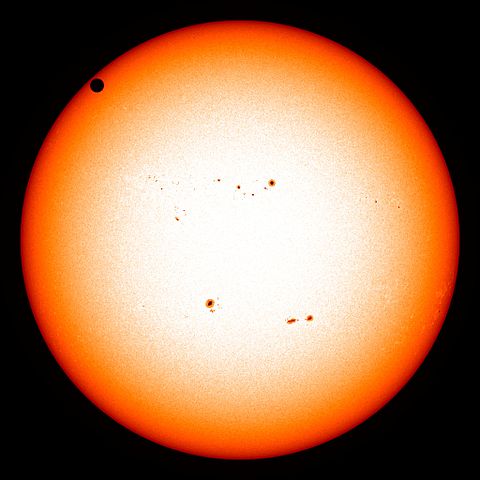Venusian Blinds

On June 5th and 6th, 2012, the planet Venus passed directly between the Earth and the Sun, a predictable astronomical event known as the “Transit of Venus.” If you were watching and staring at the Sun (with proper glasses or the like), you saw a little black dot slowly move across the sun’s face — it’s that circle at about 10 or 11 o’clock above. If you weren’t watching, well, some bad news: the next time this happens will be in December of 2117, and by then, … well, you know. (Don’t worry, though, there’s a video of the Transit of Venus up on YouTube, here.) Transits of Venus come in pairs, about eight years apart, so there was also one in 2004, and if you miss the 2117 one, there will be another in 2125.
The predictable nature of the Transit of Venus has been known for a while. The Transit was first observed in 1639 and astronomers quickly (relatively speaking) deduced that it would occur again in 1761 and 1769. This predictability allowed for coordination by the world’s scientific community at the time. Around 1759, a handful of astronomers traveled the globe to observe the Transit, hoping, collectively, to triangulate the data and measure the Earth’s distance from the Sun. One of these scientists was a French man named Guillaume Le Gentil, who was part of an expedition to India.
He should have stayed home.
In March of 1760, Le Gentil set off from France to Puducherry, a city on the Indian shore of the Bay of Bengal then under French rule. (Here’s a map.) He made it most of the way there within a few months, but the rest of the trip would take about a year. France was at war with Great Britain (as part of the Seven Year’s War), making travel difficult for French ships in the region. To make matters worse, he ran into monsoon season, blowing his ship off course for a few months — enough time for Puducherry to fall under British control. Despite arriving in the general region in time, Le Gentil was therefore unable to get to Puducherry to set up his equipment. When Venus passed between the Earth and the Sun, Le Gentil was on a boat at sea; as he had varying coordinates, he was unable to gather any valuable data.
But he didn’t go home. When he finally arrived in India (after an aborted attempt to set up shop in the Philippines, where the Spanish had taken over and weren’t open to French men stargazing), he decided to simply get a head start on the second Transit, coming toward the end of the decade. This was a valiant effort underscoring his dedication to science, and one which would have certainly paid dividends, especially since the war ended well before 1769. Unfortunately, not all difficulties are caused by mankind. Nature was about to play a cruel joke on Le Gentil. For when Venus passed between him and the Sun, so did a cloud cover, preventing him from seeing the astronomical event and, therefore, from taking any measurements whatsoever. His life’s calling had come and gone, a failure.
And then it got even worse.
The next Transit of Venus wouldn’t occur until 1874, and Le Gentil wouldn’t be around for that one. There was little reason for him to stay in India, so he went home — or tried to, at least. What should have been a relatively simply return trip in 1769 was a horror show in its own right. Bad weather and a bout with dysentery required at least one stop — one which grounded the ship he started his return voyage upon. Ultimately, Le Gentil found passage on a Spanish ship which took him the rest of the way to Paris. He arrived back home in 1771, where he found everything was just like he left it.
Except for the fact that he had been officially declared dead.
One of the downsides of international travel in the mid-1700s was that it was rather risky, and if you didn’t return rather soon, it suggested heavily that you were dead. No one thought Le Gentil’s trip to Puducherry would take eleven-plus years, especially since the purpose of his trip — the first Transit of Venus — came and went toward the beginning of those eleven years. Perhaps a return trip and some other stuff took another year or two, but ten? Out of the question.Therefore, Le Gentil’s family and employer had presumed that he died somewhere along the way during this lost decade. And they acted accordingly. As Wikipedia retells, his wife remarried, his employer (the Royal Academy of Sciences) replaced him, and his heirs were divvying up his estate. He returned to France a ruined, forgotten man.
But not all was lost, at least not forever. Over the remaining two decades of his life, Le Gentil recovered some lost assets in litigation, ended up getting his job back (but not his wife), and remarried, otherwise living a relatively private life.
Bonus fact: It takes about 224.65 Earth days for Venus to make one revolution around the Sun. On the other hand, it takes about 243 Earth days for Venus to make one rotation around its axis. In other words, one Venusian year is actually a little shorter than one Venusian day.
From the Archives: Dark Sark: An island designed for stargazers. The bonus fact also contains perhaps the worst attempted invasion in the history of mankind.
Related: “The Day the World Discovered the Sun: An Extraordinary Story of Scientific Adventure and the Race to Track the Transit of Venus” by Mark Anderson. Discusses the other (more successful) treks in the 1760s. 4.8 stars on 14 reviews, available on Kindle.
